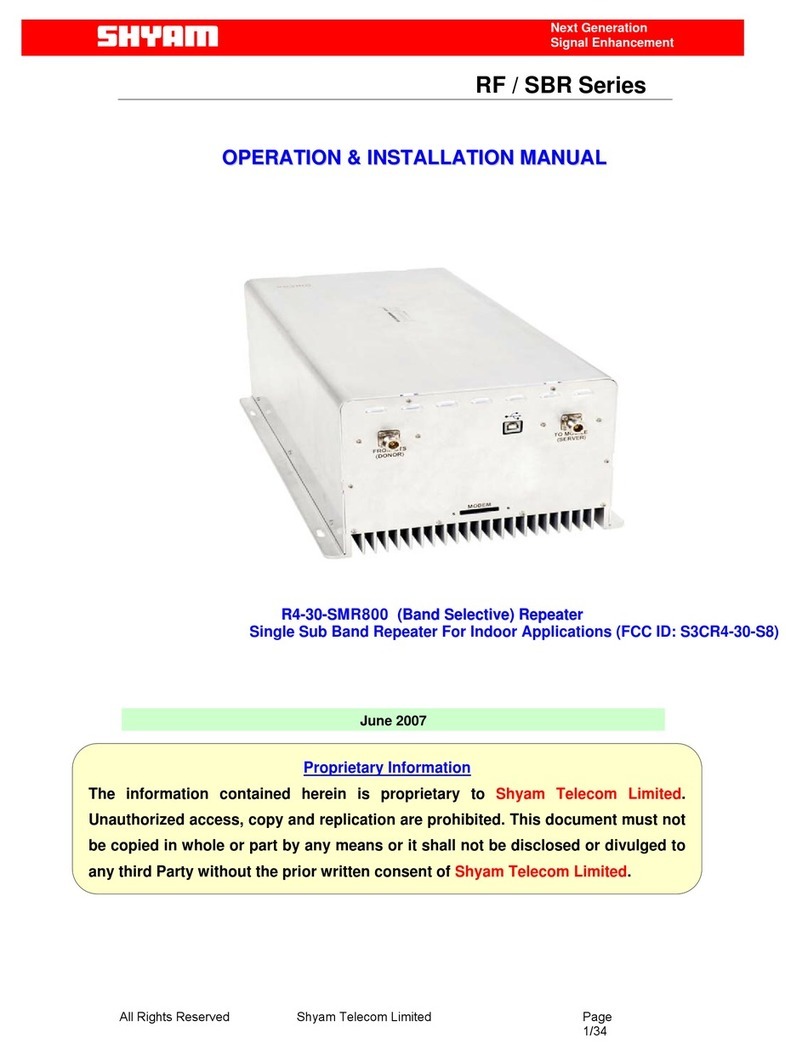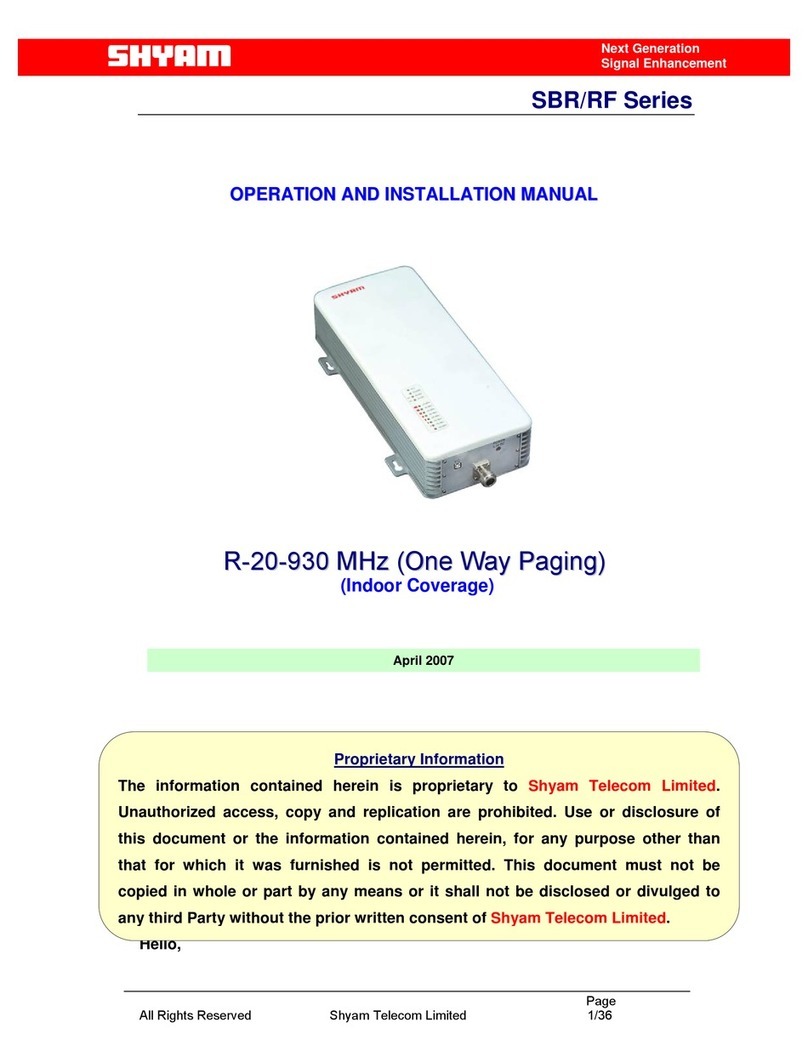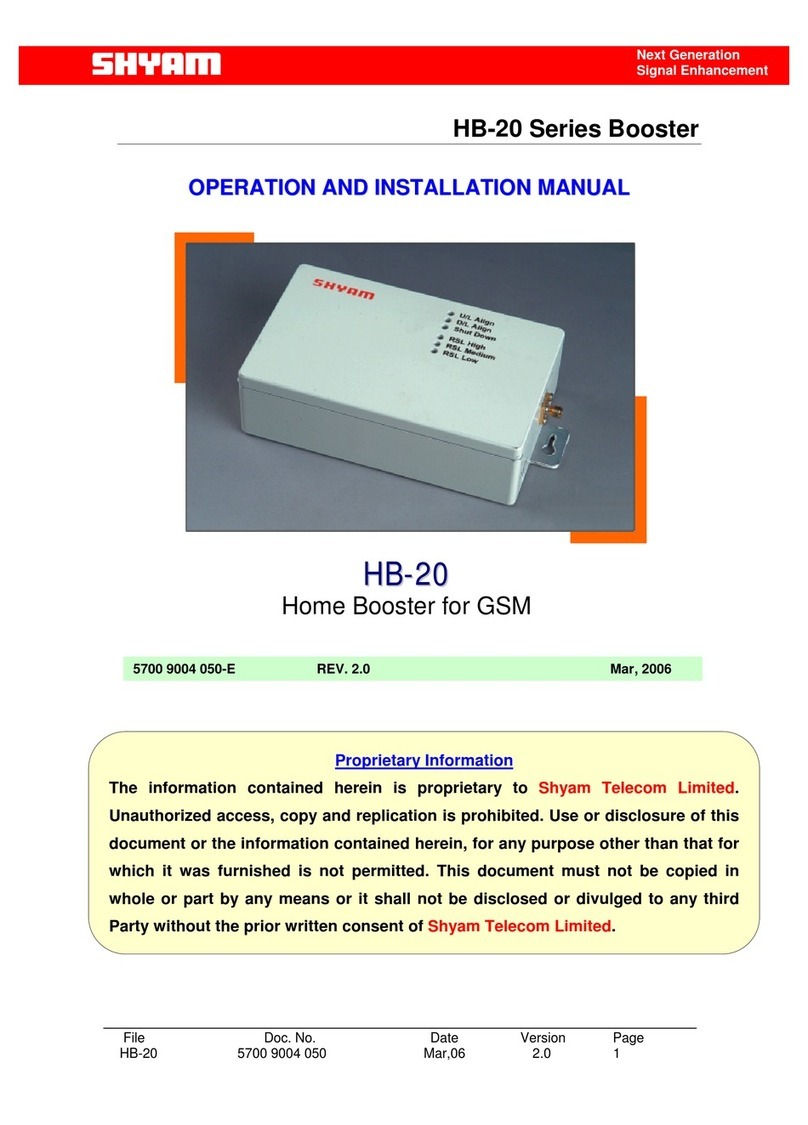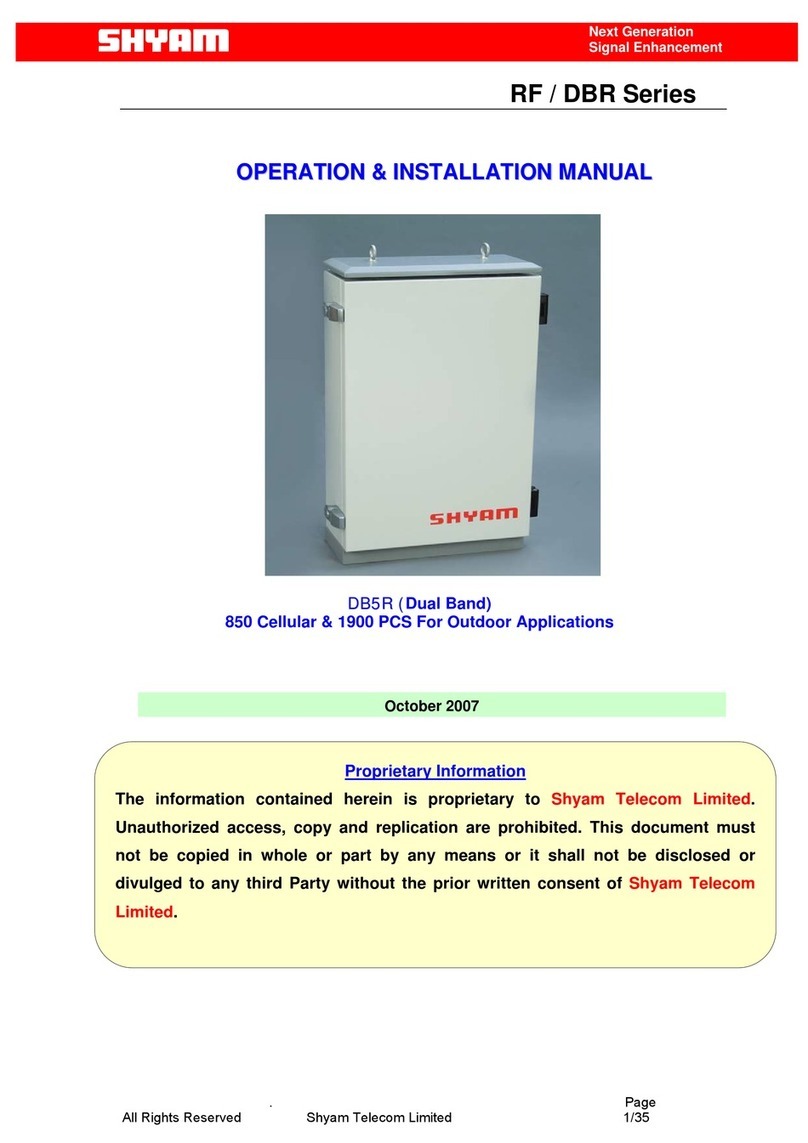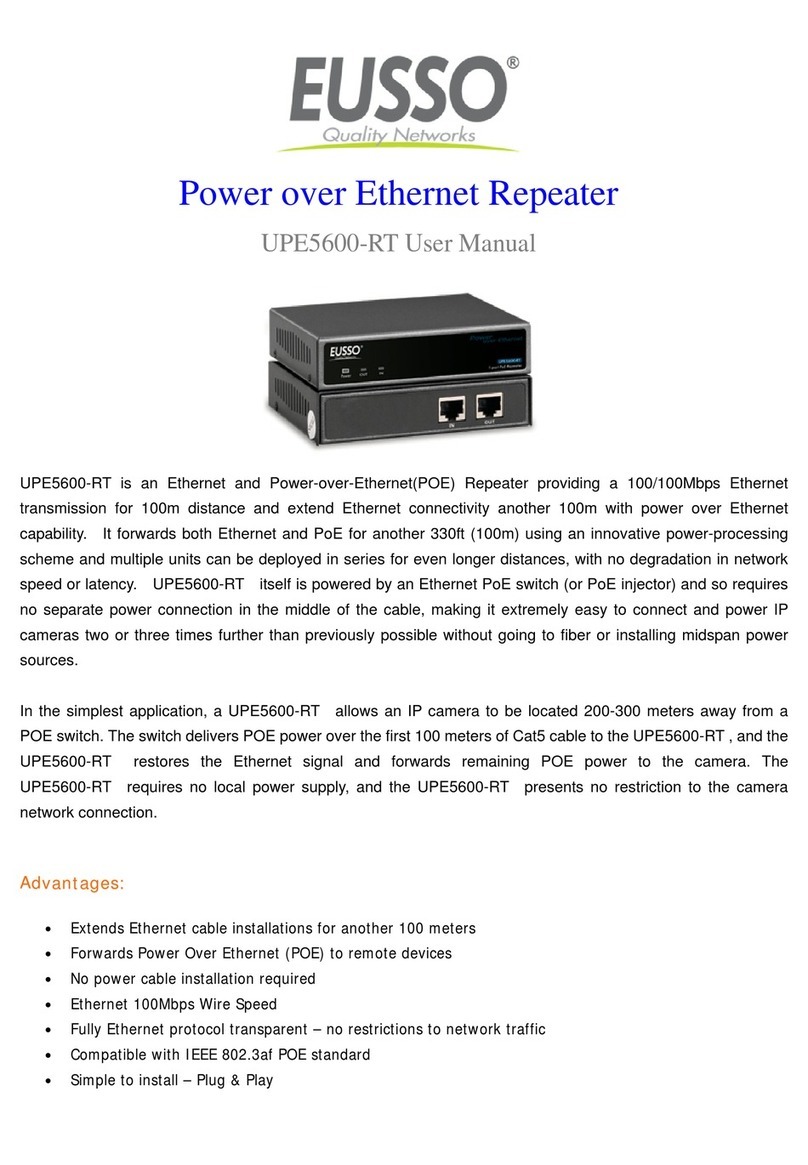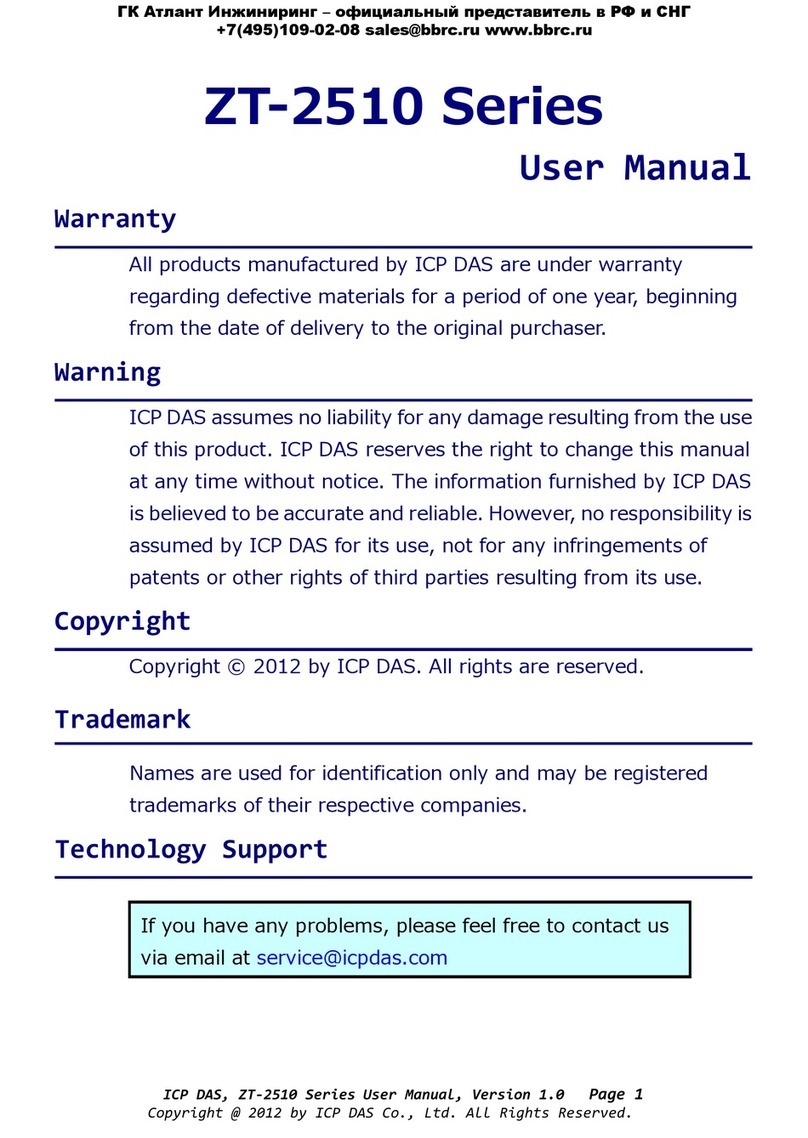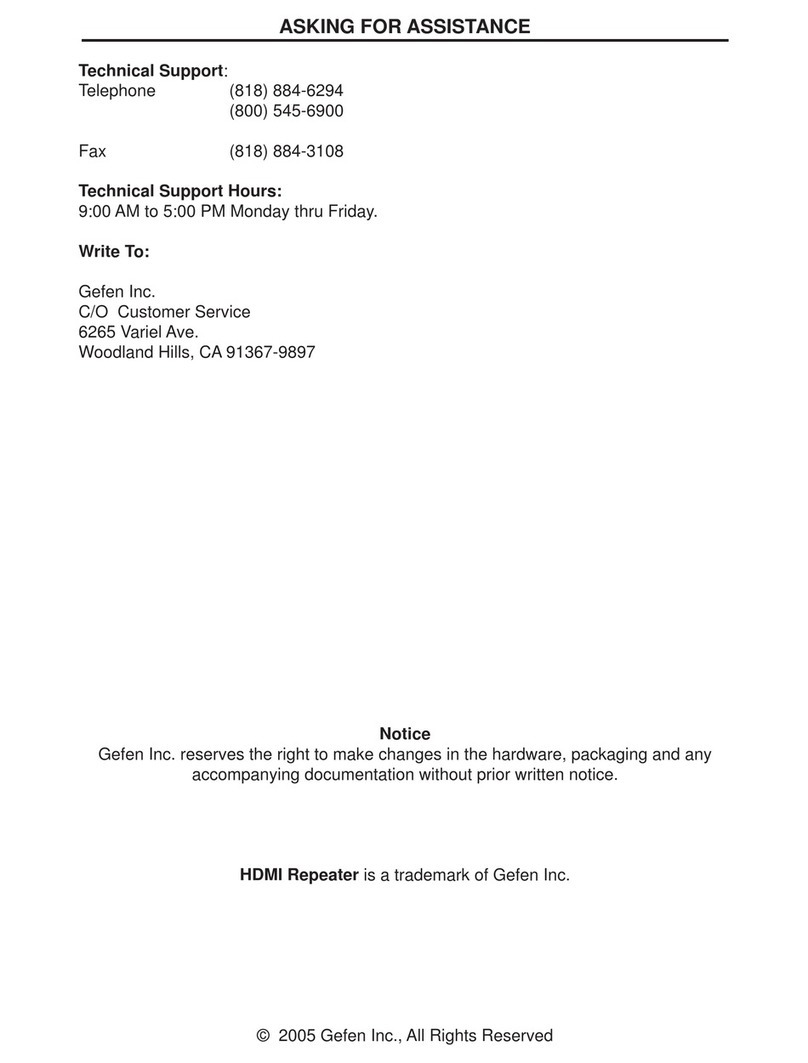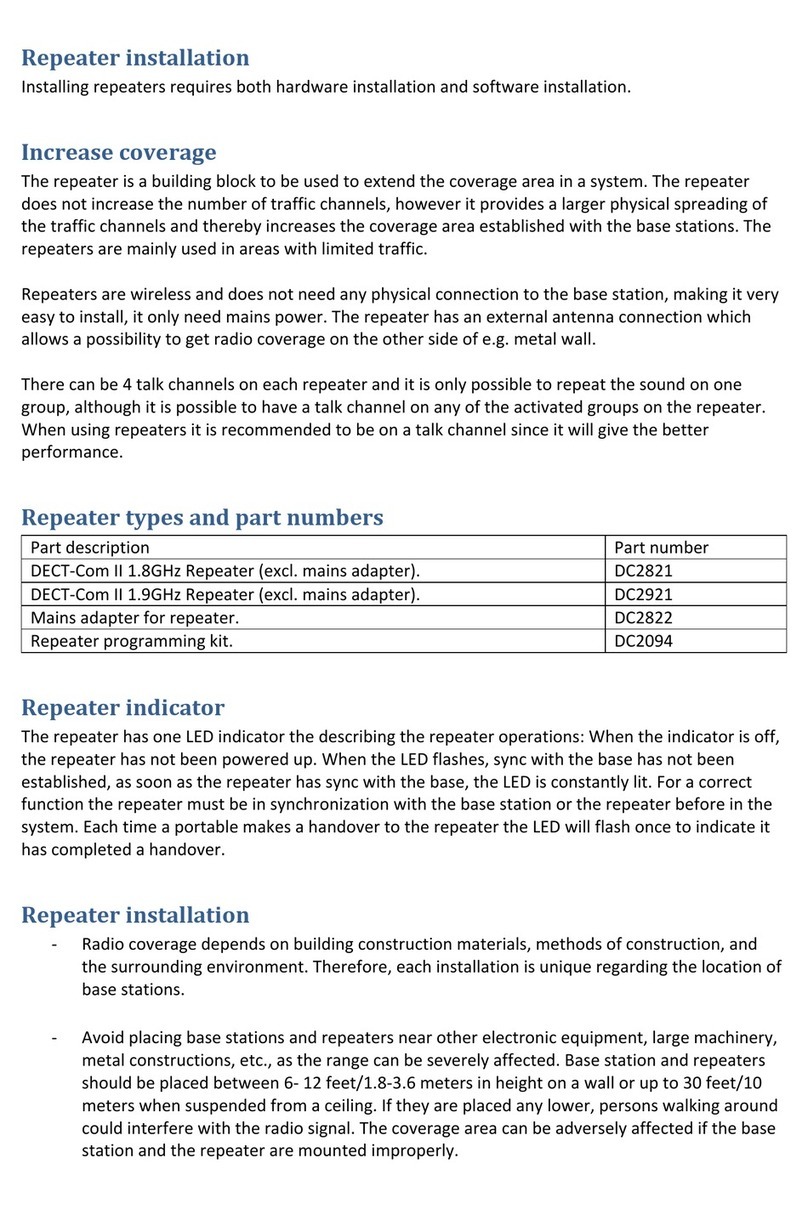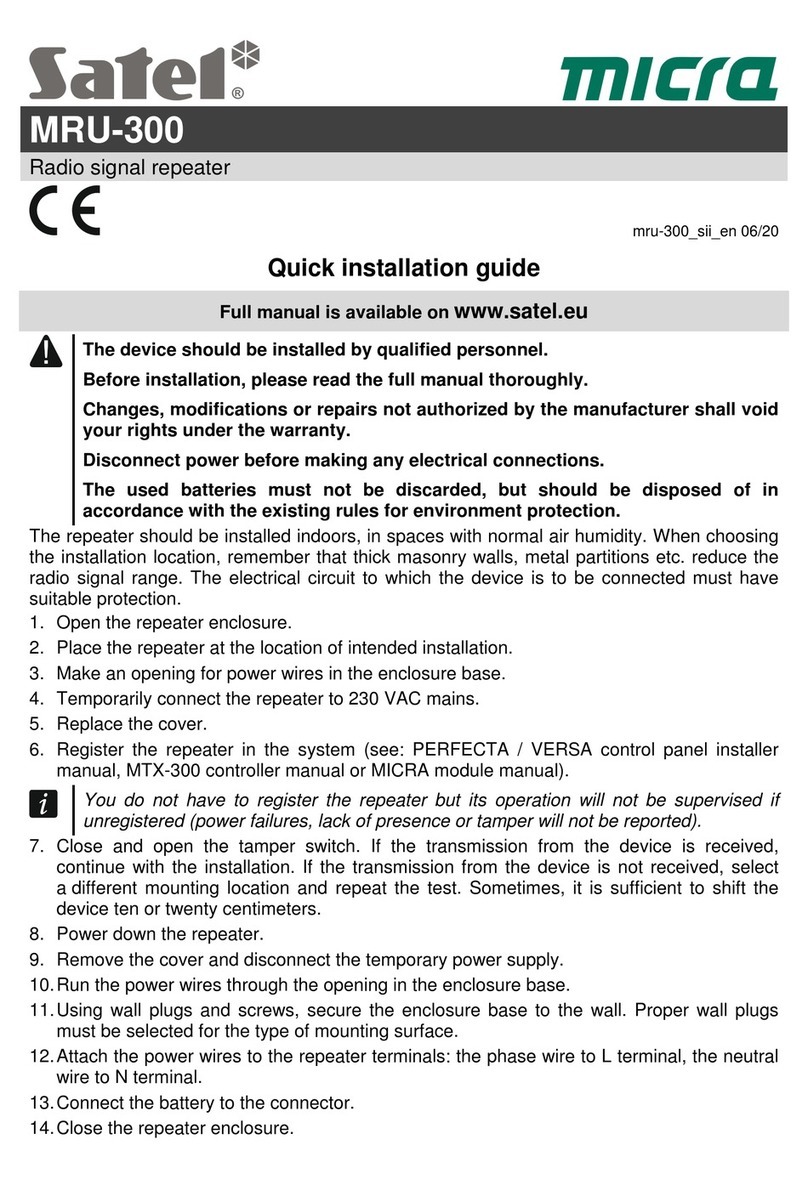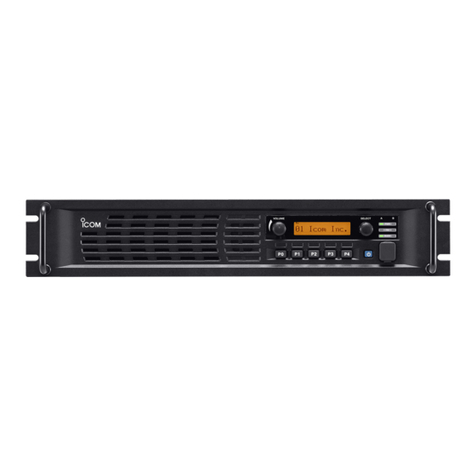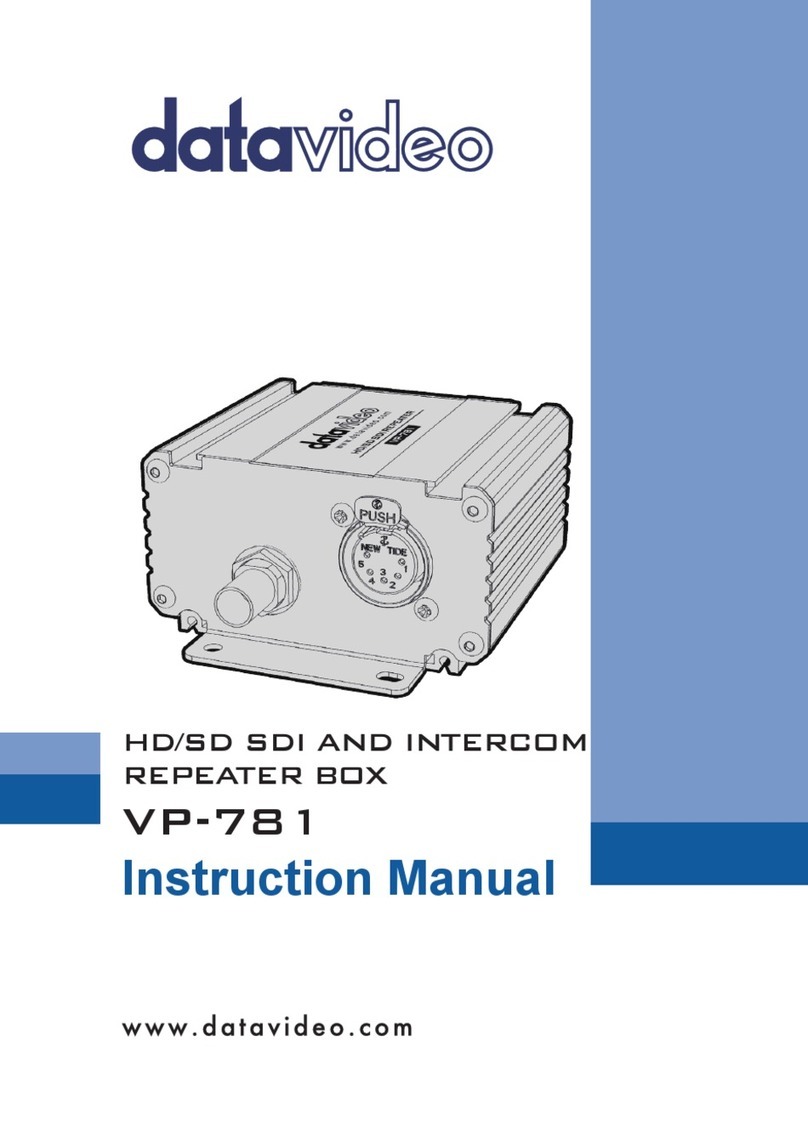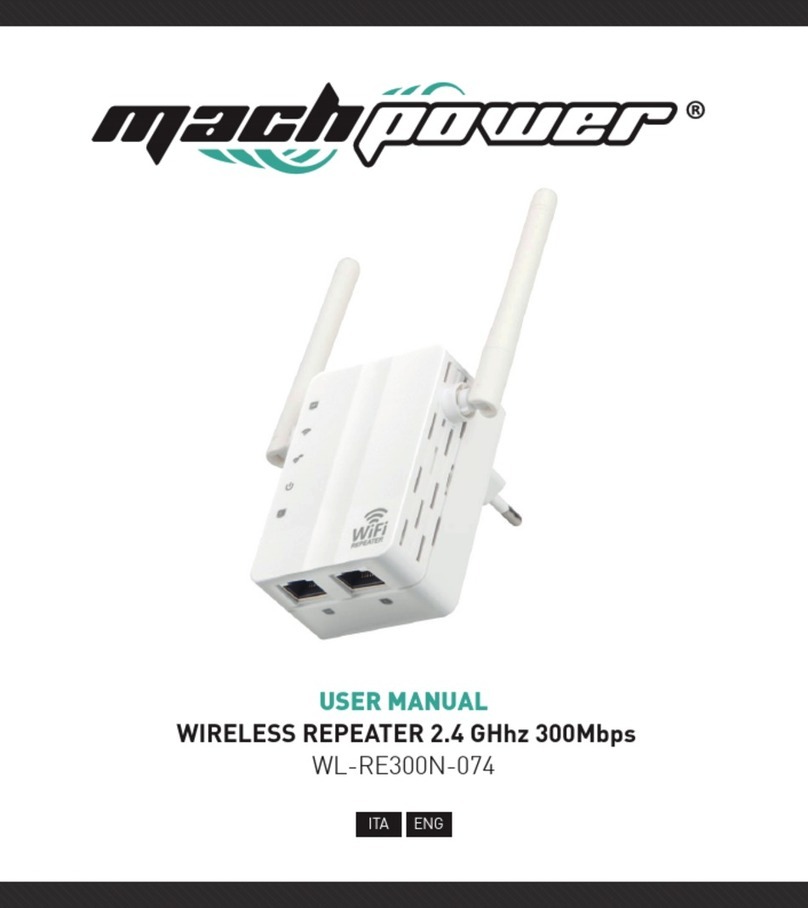Shyam RF/DBR Series User manual

Page
All Rights Reserved Shyam Telecom Limited 1/43
Next Generation
Signal Enhancement
RF / DBR Series
O
OP
PE
ER
RA
AT
TI
IO
ON
N
&
&
I
IN
NS
ST
TA
AL
LL
LA
AT
TI
IO
ON
N
M
MA
AN
NU
UA
AL
L
FCC ID:S3CDB6MR20 IC: 5751A-DB6MR20
5920 0060 200 December 2008
Proprietary Information
The information contained herein is proprietary to Shyam Telecom Limited.
Unauthorized access, copy and replication are prohibited. This document must not
be copied in whole or part by any means or it shall not be disclosed or divulged to
any third Party without the prior written consent of Shyam Telecom Limited.
D
DB
B6
6M
MR
R2
20
0(
(Dual Band)
Six Sub-Band Repeaters for In-Door Applications

Page
All Rights Reserved Shyam Telecom Limited 2/43
Next Generation
Signal Enhancement
Contents
1. Document History.........................................................................................4
2. Disclaimer......................................................................................................5
3. Safety Instructions and Warnings...............................................................5
3.1. Personnel Safety .....................................................................................5
3.2. Equipment Safety....................................................................................5
3.3. Electrostatic Sensitivity............................................................................6
4. Introduction...................................................................................................7
4.1. Purpose...................................................................................................7
4.2. Scope......................................................................................................7
4.3. Definitions................................................................................................7
4.4. References..............................................................................................8
4.5. General....................................................................................................8
5. Functional Description of DB6MR20 Repeater...........................................9
5.1. General Description.................................................................................9
5.2. Typical In-Building Coverage.................................................................11
6. To Get started-Basic Software Control of the System.............................14
6.1. General..................................................................................................14
6.2. Terminal Set-up.....................................................................................14
6.3. Block Diagram Description ....................................................................24
7. DB6MR20 Repeater Specifications............................................................26
7.1 Specification-RF .....................................................................................26
7.2. Electrical Specification Power Requirement ..........................................26
7.3. External Electrical Interface...................................................................27
7.4. Mechanical Specification.......................................................................27
7.5. Environmental Specification ..................................................................27
7.6. Contents of Delivery ..............................................................................27
8. Installation...................................................................................................28
8.1. Preparation Sheet-Pre Installation.........................................................28
8.2. Engineering Consideration ....................................................................29
8.3. Installation Tools....................................................................................31
8.4. Installation Procedure............................................................................32
8.5. Gain Settings.........................................................................................33
8.6. Commissioning......................................................................................34
8.7. Checklist – Post Installation...................................................................35

Page
All Rights Reserved Shyam Telecom Limited 3/43
Next Generation
Signal Enhancement
8.8. Dos & Don’t Dos....................................................................................36
8.9. Display Details of DB6MR20 .................................................................37
9. System Maintenance...................................................................................38
9.1. General..................................................................................................38
9.2. Preventative Maintenance.....................................................................38
9.3. In-Building Coverage Problems.............................................................38

Page
All Rights Reserved Shyam Telecom Limited 4/43
Next Generation
Signal Enhancement
1. Document History
Document
Number Document
Name Date Compiled
by Approved by Revision
5920 0060 200 DB6MR20
Repeater December
2008 Inderjit Ramvir Singh
Revision Revised Section Date
Intentionally Left Blank

Page
All Rights Reserved Shyam Telecom Limited 5/43
Next Generation
Signal Enhancement
2. Disclaimer
Every attempt has been made to make this material complete, accurate, and
up-to-date. Users are cautioned, however, that Shyam Telecom Limited
reserves the right to make changes without notice and shall not be
responsible for any damages including consequential, caused by reliance of
the contents presented, including, but not limited to, typographical,
arithmetical, or listing errors.
Product name(s) referenced in this document may be trademarks or
registered trademarks of their respective companies, and are hereby
acknowledged.
In areas with unstable power grids (mains) all repeaters must be installed with
a voltage regulator ensuring a constant voltage level at the repeater power
input. A maximum voltage deviation should remain within the input range to
the repeaters for warranty purposes.
All antennas must be installed with lighting protection. Damage to internal
modules, as a result of lightning is not covered by the warranty.
All specifications are subject to change without prior notice.
3. Safety Instructions and Warnings
3.1. Personnel Safety
Before installing or replacing any equipment, the entire manual should be
read and understood. The user needs to supply the appropriate AC power to
the Repeater. Incorrect AC power settings can damage the repeater and may
cause injury to the user.
Throughout this manual, there are "Caution" warnings, "Caution" calls
attention to a procedure or practice, which, if ignored, may result in injury or
damage to the system or system component or even the user. Do not
perform any procedure preceded by a "Caution" until the described
conditions are fully understood and met.
3.2. Equipment Safety
When installing, replacing or using this product, observe all safety
precautions during handling and operation. Failure to comply with the
following general safety precautions and with specific precautions described
elsewhere in this manual violates the safety standards of the design,
manufacture, and intended use of this product. Shyam Telecom Limited
assumes no liability for the customer's failure to comply with these
precautions. This entire manual should be read and understood before
operating or maintaining the repeater system.

Page
All Rights Reserved Shyam Telecom Limited 6/43
Next Generation
Signal Enhancement
CAUTION
It calls attention to a procedure or practice which, if not followed, may result in
personal injury, damage to the system or damage to individual components. Do
not perform any procedure preceded by a
CAUTION until described conditions are fully understood and met.
WARNING! This equipment complies with FCC & IC radiation exposure limits
set forth for an uncontrolled environment. This transmitter must not be co-
located or operating in conjunction with any other antenna or transmitter.
The signal booster with server antenna must be installed to provide minimum
20 cm separation distance between the server antenna and the body of user
or near by person. The donor antenna used for this transmitter must be fixed-
mounted on outdoor permanent structures with a separation distance of at
least 1.5 meters from all persons during normal operation.
The RF electric performance of the DB6MR20 repeater conforms to FCC
requirement of the inter modulation and spurious emission. It avoids
interference problems.
3.3. Electrostatic Sensitivity
CAUTION
ESD = ELECTROSTATIC DISCHARGE SENSITIVE DEVICE
Observe electrostatic precautionary procedures.
Semiconductor transmitters and receivers provide highly reliable performance
when operated in conformity with the intentions of their design. However, a
semiconductor may be damaged by an electrostatic charge inadvertently
imposed by careless handling.
Static electricity can be conducted to the semiconductor chip from the centre
pin of the RF input connector, and through the AC connector pins. When
unpacking and otherwise handling the Repeater, follow ESD precautionary
procedures including the use of grounded wrist straps, grounded workbench
surfaces, and grounded floor mats.

Page
All Rights Reserved Shyam Telecom Limited 7/43
Next Generation
Signal Enhancement
4. Introduction
4.1. Purpose
The purpose of this document is to describe the electrical and mechanical
specifications, operation and maintenance of the DB6MR20 Repeater.
4.2. Scope
This document is the product description of the Shyam DB6MR20 Repeater
for indoor applications.
4.3. Definitions
AGC Automatic Gain Control
ALC Automatic Level Control
APC Automatic Power Control
BCCH Broadcast Control Channel
BTS Base Transceiver Station
BSEL Band Selective
CDMA Coded Division Multiple Access
CMC Configuration & Monitoring Console software
CMB Combiner Unit
CSEL Channel Selective
DCS Digital Communication System
DL Downlink signal (from base station via repeater to
mobile station)
EGSM Extended Global System for Mobile Communication
ETSI European Telecommunications Standard Institute
GSM Global System for Mobile communication
LAC Location Area Code of the BTS site
LED Light Emitting Diode
LNA Low Noise Amplifier
LO Local Oscillator
MS Mobile Station
MSC Mobile Switching Center
NMS Network Management System
PA Power Amplifier
PCN Personal Communication Network
PCS Personal Communication System
PSU Power Supply Unit
RF Radio Frequency
RMS Remote Management System
RSSI Received Signal Strength Indication
RTC Real Time Clock
TACS Total Access Communication System
TDMA Time Division Multiple Access
UL (Uplink) Uplink signal direction (from mobile station via
repeater to base station)

Page
All Rights Reserved Shyam Telecom Limited 8/43
Next Generation
Signal Enhancement
4.4. References
[1] ETS 300 086.
Radio Equipment and Systems Land mobile service Technical
characteristics and test conditions for radio equipment with an internal or
external RF connector intended primarily for analogue speech.
[2] ETS 300 609-4.
Digital cellular telecommunications system (phase 2): Base Station
Systems (BSS) equipment specification: Part 4: Repeaters.
[3] ETS 300 342-3
Radio Equipment and Systems (RES): Electro-Magnetic Compatibility
(EMC) for European Digital Cellular Telecommunications systems. Base
Station Radio and ancillary equipment and Repeaters meeting phase 2
GSM requirements.
4.5. General
Mobile Communications Systems are planned as cellular systems and each
cell of the base station is required to provide RF coverage over a certain
geographical area as per defined RF power levels. Due to the RF propagation
properties, even using high radiated RF powers or complicated antenna
systems, there are zones within the coverage area where the RF signal
strength from base station remains inadequate for establishing the desired
connectivity to mobile users.
Repeaters traditionally are deployed in the Mobile Communication Network to
fill in the “Dead Zones” caused by blocking of signals by geographic
topologies such as mountains, valleys, dense foliage, high rising urban
landscapes and other man-made structures. The distance from the base
station also adversely affects the RF signal strength. The user views
repeaters as a means to extend base station coverage so as to reduce the
number of base stations and thereby accelerate network availability.
Repeater systems are installed after meticulous planning between BTSs and
the mobile users to provide RF coverage in the shadowed regions. Repeater
systems are available for different applications and ultimate choice shall
depend on some of the factors mentioned below:
•Area to be provided with coverage.
•Indoor/outdoor coverage.
•Availability of BTSs in the vicinity.
•Antenna isolation to be achieved.

Page
All Rights Reserved Shyam Telecom Limited 9/43
Next Generation
Signal Enhancement
5. Functional Description of DB6MR20 Repeater
5.1. General Description
The DB6MR20 Repeater System is a designed to provide indoor coverage
and can handle signals in up to six sub bands in two of the service bands,
used around the World by various service operators. It provides highly
selective amplification in the pre-set bands. The details of operating service
frequency bands are given below:
S.NO. Service Band DL Frequency (MHz) UL Frequency (MHz)
1. SMR 800 851-866 806-821
2. Cellular 869-894 824-849
3. SMR 900 935-941 896-902
4. EGSM 925-960 880-915
5. GSM 900 935-960 890-915
6. DCS 1805-1880 1710-1785
7. PCS 1930-1990 1850-1910
8. UMTS 2110-2170 1920-1980
*The certification for FCC ID:S3CDB6MR20 & IC:5751A-DB6MR20 is only applied to Cellular
and PCS Band applications.
The Customer is advised to refer to the sticker on the repeater unit giving the
details of frequency bands set & the bandwidths of different sub bands
equipped in the repeater.
Salient Features
•The repeater has been designed to meet the requirement of users
who are allocated frequency spectrum in different bands. It is
provisioned to be equipped up to six sub bands maximum in both the
bands with 3+3 configuration.
•The repeater adopts duplex mode and bi-directional amplification for
UL & DL signals between the base station and mobile users. It has
been designed for indoor applications to meet the requirements of
large number of users in the targeted area.
•It conforms to ETSI standards & international safety
requirements.
•The system can be incorporated with optional Remote
Management System (RMS). It enables status monitoring, remote
configuration & speedy maintenance.
•The system is modular in nature & can be customized to meet
requirement of user in terms of number of sub bands with the desired

Page
All Rights Reserved Shyam Telecom Limited 10/43
Next Generation
Signal Enhancement
bandwidth of each. The System is incorporated with monitoring
facility through USB port with easy GUI interface.
•It sucks signals from the BTS through a DONOR antenna (highly
directional outdoor antenna) and distributes the signals to mobile
users after amplification through a set of indoor SERVER antenna(s)
(omni/ directional) system in the DL.
•In the UL, the signals from the mobile users are picked up by
SERVER antenna and retransmitted to the BTS after processing &
amplification in the repeater.
The repeater consists of the following modules/units:
•LNA
•Converters
Power amplifiers
Power supply unit
Quad-plexers filters for transmit/receive directions
Supervisory module
A metallic case houses the repeater. Provision is made for heat
dissipation especially for amplifiers, which generate more heat. The
choice of suitable metal as the case material gives a lightweight
design with good heat conduction. It is not waterproof and therefore,
should be installed at indoor locations only.
Ceiling
Antenna

Page
All Rights Reserved Shyam Telecom Limited 11/43
Next Generation
Signal Enhancement
Figure 1: Typical In-building Coverage
5.2. Typical In-Building Coverage
The DB6MR20 repeater is designed to provide optimal coverage over an
area of approximately 1,000 to 2,000 sq. meters (10,000 to 20,000 Sq ft.).
However, ultimate performance depends on the obstructions
blocking/absorbing of the RF signals in side the building and the available
forward signal level at the donor antenna.
Typical coverage is usually planned for relatively small areas such as large
conference rooms or several adjacent rooms in smaller office areas.
Coverage is primarily determined by the available forward signal level at the
outdoor antenna input, loss due to the RF cable length, type of RF cable
installed and achievable isolation for optimum DB6MR20 performance.
Indoor coverage varies greatly due to the nature of various building
construction techniques and materials. Approximations of signal
level/coverage can be determined with the following assumptions:
•10dBi to12dBi-donor antenna. Max. 9dBi indoor
omni/directional antenna.
DB6R20 unit

Page
All Rights Reserved Shyam Telecom Limited 12/43
Next Generation
Signal Enhancement
•Installed total cable and connector loss of approximately 5 dB
(125 feet of typical 1/2” coaxial foam cable).
•Interior building structure consists of typical vertical stud and
drywall composition.
•Isolation between the donor and server antennas should be 15
dB more than the gain of the repeater.
Figure 2: Application of DB6MR20 in a multi-storey building
DB6R20
Repeater

Page
All Rights Reserved Shyam Telecom Limited 13/43
Next Generation
Signal Enhancement
Figure 3: Typical Indoor Coverage Application in Train
Ceiling
Antenna
DB6MR20

Page
All Rights Reserved Shyam Telecom Limited 14/43
Next Generation
Signal Enhancement
6. To Get started-Basic Software Control of the System
6.1. General
The system is equipped with a supervisory module that allows the monitoring
and control of various parameters such as RF power, attenuation,
temperature, status of door and alarm conditions etc.
The communication interface between the local terminal and the control
module can be set up using the Configuration & Monitoring Console software
(CMC), which is an easy to use GUI for simple control and monitoring. It
enables monitoring of parameters & subsequent adjustment if required.
This function can be performed either using a terminal (PC/laptop) locally, or
through remote login using the wireless modem (Optional) located in the
repeater. USB port is provisioned in the equipment for connecting PC/laptop.
6.2. Terminal Set-up
The system is delivered with software loaded in order to perform configuration
as per requirement. The laptop/PC should be loaded with the CMC software
available on the supplied CD along with the USB driver.
Functions as described below are carried out through CMC software:
I) Login Repeater (Figure 4)
After running the Configuration & Monitoring Console (CMC), user needs to
login the repeater. To login the repeater:
•Click the “Login” on the command bar.
•Select the user type.
•Enter the password.
•Finally click the “OK”.
After successful login, a message “Logged in successfully” will be flashed
on the screen. Now user can start the operation through CMC.
There are two types of users viz. ADMINISTRATOR and SUPERVISOR. If
user logged in as an ADMINISTRATOR, all the operation through the CMC
can be carried out. The password by default is “SHYAM”.
SUPERVISOR is allowed to perform monitoring of the status & alarms but
no change in configuration is permitted. However, the SUPERVISOR can
change password if so desired.
Administrator can limit the system access authority of the SUPERVISOR.

Page
All Rights Reserved Shyam Telecom Limited 15/43
Next Generation
Signal Enhancement
Figure 4: Log-in Repeater
II) Configuration
Configuration means setting different repeater parameters for proper
operation. Configuration of Shyam repeaters can be performed locally with
a laptop / PC connected to the repeater by means of local USB serial
interface cable.
Clicking the CONFIGURE on the command bar, displays configuration
window. This window allows access to all the configurable repeater
parameters.
!SET: This is for updating the repeater parameters.
!READ: This is for reading configured parameters from repeater.
Repeater ID (Figure 5)
User can assign a unique repeater ID to each repeater installed. Up to 10
characters are allowed for this field.
Repeater Location (Figure 5)
User can assign the address of location where repeater is installed. Up to
30 characters are allowed for this field.
UP Link/ DL Frequency (Figure 6)
The UL /DL frequency ranges are defined for all the equipped sub bands
(Maximum up to six) depending on the bands being used.

Page
All Rights Reserved Shyam Telecom Limited 16/43
Next Generation
Signal Enhancement
Figure 5: Repeater ID/Location Settings
Figure 6: Frequency Settings in sub bands

Page
All Rights Reserved Shyam Telecom Limited 17/43
Next Generation
Signal Enhancement
Figure 7: Sub Band ON/OFF Settings
Sub Band ON/OFF Settings (Figure 7)
Depending on the number of sub bands equipped, particular sub bands
can be configured as “ON” & others “OFF”. Maximum six sub bands can
be equipped.
PA ON/OFF (Figure 8)
User can set UL and/or DL PA as ON or OFF independently for testing
purpose at the time of installation.
After completing the installation it must be in ON condition only.
Threshold Settings for Output Power (Figure 9)
Maximum Output Power limit in DL & UL paths are defined. PA Power
“High” alarm will be generated when PA power exceeds the upper limit.
RSSI limits (Figure 9)
Lower & High RSSI Limits in downlink & uplink paths are set in the factory.
A RSSI “High” alarm will be generated when RSSI exceeds the upper
limit, and a RSSI “Low” alarm will be generated when RSSI goes below
the lower limit set by user. Upper and lower ranges that can be set byuser
vary from -50 to -80dBm.
Attenuation Settings (Figure 10)
Through this setting, the attenuation is inserted in both the bands in UL &
DL paths as per the requirement of RF power. It is carried out when the
system is set in manual mode. In automatic mode whatever attenuation is
inserted, is displayed.

Page
All Rights Reserved Shyam Telecom Limited 18/43
Next Generation
Signal Enhancement
Figure 8: PA ON/OFF Settings
Figure 9: Threshold Settings

Page
All Rights Reserved Shyam Telecom Limited 19/43
Next Generation
Signal Enhancement
Figure 10: Attenuation Settings
III) Monitoring (Refer Figure 11)
Parameter Remarks
Attenuation (Band 1& 2) Displays UL/DL Attenuation inserted in the system in both the bands.
Output Power Displays PA output power in UL & DL paths in boththe bands.
RSSI DL Real time RSSI DL signal strength in both the bands is indicated.
Location System location is displayed.
Serial Number Serial number (factory settable) is displayed.
Repeater ID
A unique repeater ID set by the user is displayed.
5.5 V power supply Value of derived Voltage is displayed
PATemperature DL &UL Displays the temperature of PAs in DL & UL in both the bands
System Temperature Displays the temperature of the system
Alarms Displays if there is any alarm viz. critical, major or minor. Details can
be viewed by clicking at “DETAIL ALARM”.

Page
All Rights Reserved Shyam Telecom Limited 20/43
Next Generation
Signal Enhancement
Figure 11: Monitoring Status
IV) Alarms (Refer Figure 12)
Observation Remarks
Synthesizer Fail (UL
& DL) Failure of synthesizer of a particular sub band either in DL or UL is
indicated by this alarm.
PA ON/OFF
(DL & UL) Indicates the status of PA if it is ON or OFF (manual/auto) to draw the
attention of the maintenance staff.
RSSI Low (DL) Indicates that the RSSI has exceeded the lower limit set.
RSSI High (DL) Indicates that the RSSI has exceeded the higher limit set.
PA Power Low (DL) When PA Power goes below the lower limit set by the user, this alarm is
generated.
PA Power High (DL) When PA Power exceeds the upper limit set by user, this alarm is
generated.
PATemperature High
(DL & UL) Indicates the risein temperature beyond thesafety limits.
VSWR (DL & UL) Indicates when VSWR exceeds the specified limits (1.5:1) due to
mismatching.
LNA (DL &UL) Failure of LNA is indicated
System Temperature Indicates the rise in temperature of system.
Monitoring interval is 3 seconds i.e. after every 3 seconds data on the monitoring
window will be refreshed.
A red indication is for Alarm present.
A green indication is for No alarm.
This manual suits for next models
1
Table of contents
Other Shyam Repeater manuals
Popular Repeater manuals by other brands
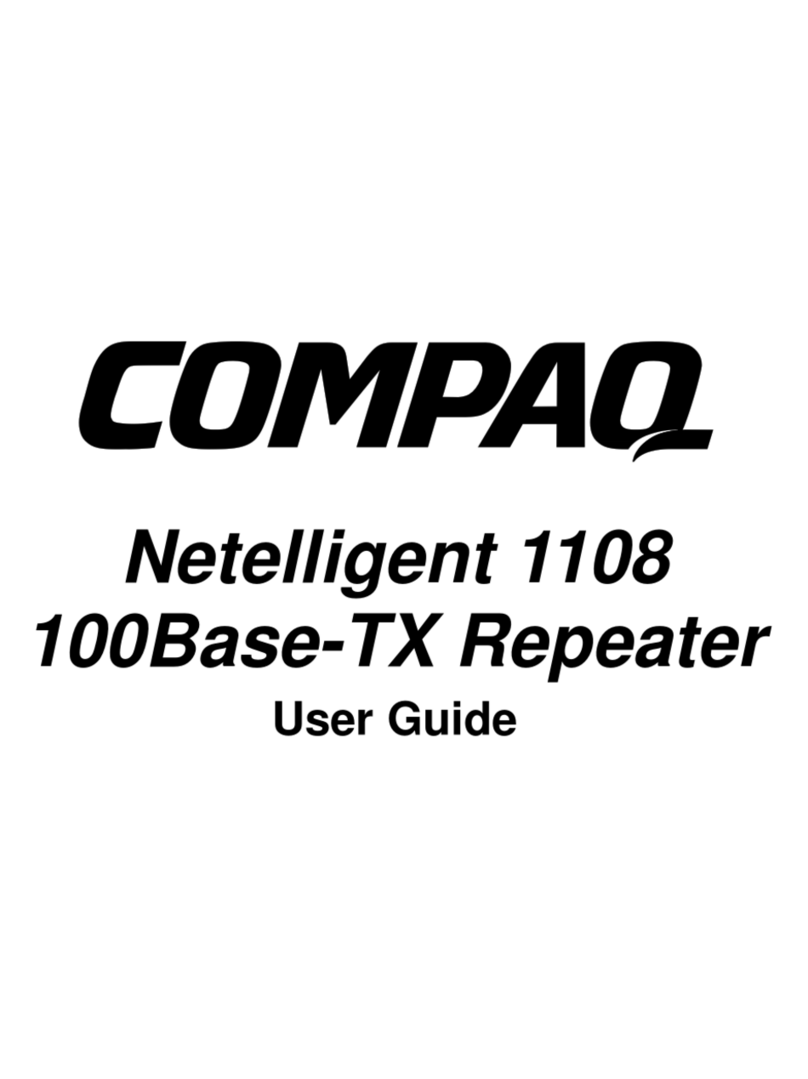
Compaq
Compaq Netelligent 1108 user guide

Pyramid Communications
Pyramid Communications SVR-250 Service manual

Alfa Network
Alfa Network AIP-W525H V2 Setup guide
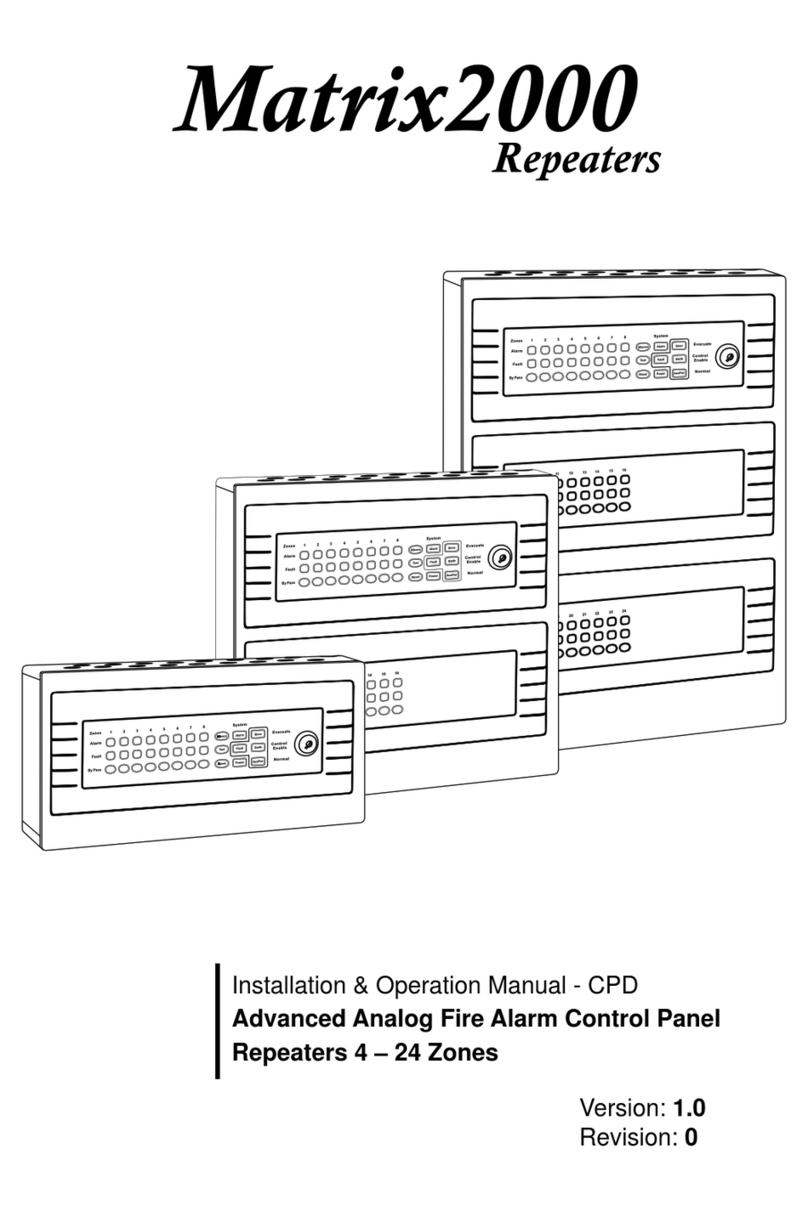
Paradox Hellas S.A.
Paradox Hellas S.A. Matrix2000 Installation & operation manual
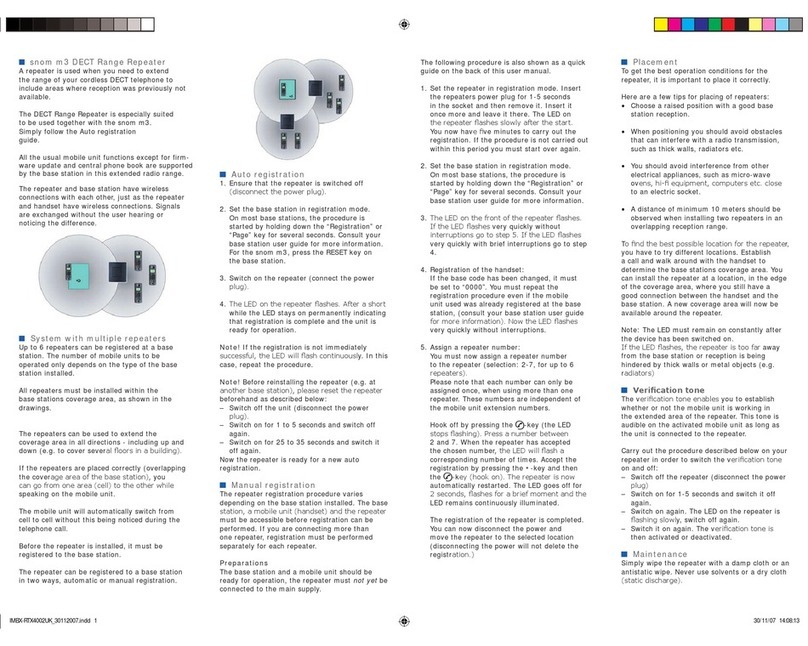
Snom
Snom M3 user manual
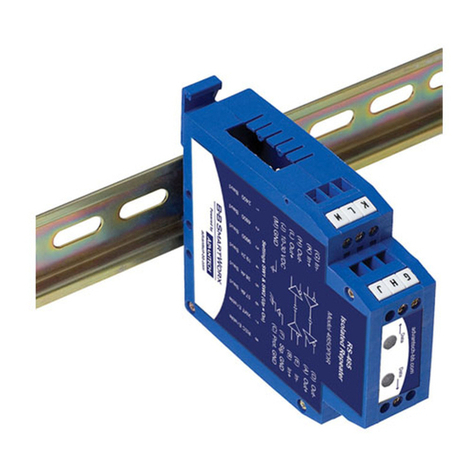
Advantech
Advantech BB-485OPDR quick start guide
